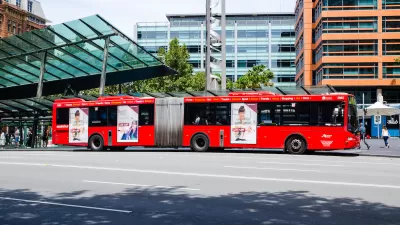Tim Williams argues that Sydney's ubiquitous and beloved terraced housing provides an exemplary model for developing environmentally efficient and livable communities. So why is their construction being stymied?
A mainstay of Sydney's housing mix until World War II, terraced housing "is characterised by small lots, attached housing, and street frontage," describes Williams.
"Because it was designed before the advent of the car, it was pedestrian
focused and close to transport. It is less land hungry than later
housing models, but provides a form of higher density living far more
desirable than badly designed apartments."
So why is it so difficult to build this housing form so prized by home-buyers and praised by New South Wales Planning Minister Brad Hazzard? According to Williams, "The answer turned out to be simple: Current council restrictions make
terraces all but unviable. If a developer wishes to build terraces, they
will typically require a rezoning and a sub-division application, which
often take years to process. Some councils even require terraces to
have underground or off-street parking, making them either prohibitively
expensive or simply not terraces at all. The result of this baffling
approach is that developers end up building either McMansions in
sprawling suburbs or high-rise apartments. The former isn't sustainable
and the latter isn't popular."
Williams calls on the state government to "hold a design competition to update the terrace in line with modern family needs" and to "encourage small lot, terrace or semi-detached housing within a 600-metre radius of every train station," in order to support a return to this time-tested precedent and more effectively meet Sydney's housing needs.
FULL STORY: Acceptable density: reinventing the Sydney Terrace for the 21st Century

Alabama: Trump Terminates Settlements for Black Communities Harmed By Raw Sewage
Trump deemed the landmark civil rights agreement “illegal DEI and environmental justice policy.”

Planetizen Federal Action Tracker
A weekly monitor of how Trump’s orders and actions are impacting planners and planning in America.

The 120 Year Old Tiny Home Villages That Sheltered San Francisco’s Earthquake Refugees
More than a century ago, San Francisco mobilized to house thousands of residents displaced by the 1906 earthquake. Could their strategy offer a model for the present?

San Francisco Opens Park on Former Great Highway
The Sunset Dunes park’s grand opening attracted both fans and detractors.

Oregon Legislature to Consider Transit Funding Laws
One proposal would increase the state’s payroll tax by .08% to fund transit agencies and expand service.

Housing Vouchers as a Key Piece of Houston’s Housing Strategy
The Houston Housing Authority supports 19,000 households through the housing voucher program.
Urban Design for Planners 1: Software Tools
This six-course series explores essential urban design concepts using open source software and equips planners with the tools they need to participate fully in the urban design process.
Planning for Universal Design
Learn the tools for implementing Universal Design in planning regulations.
Clanton & Associates, Inc.
Jessamine County Fiscal Court
Institute for Housing and Urban Development Studies (IHS)
City of Grandview
Harvard GSD Executive Education
Toledo-Lucas County Plan Commissions
Salt Lake City
NYU Wagner Graduate School of Public Service




























